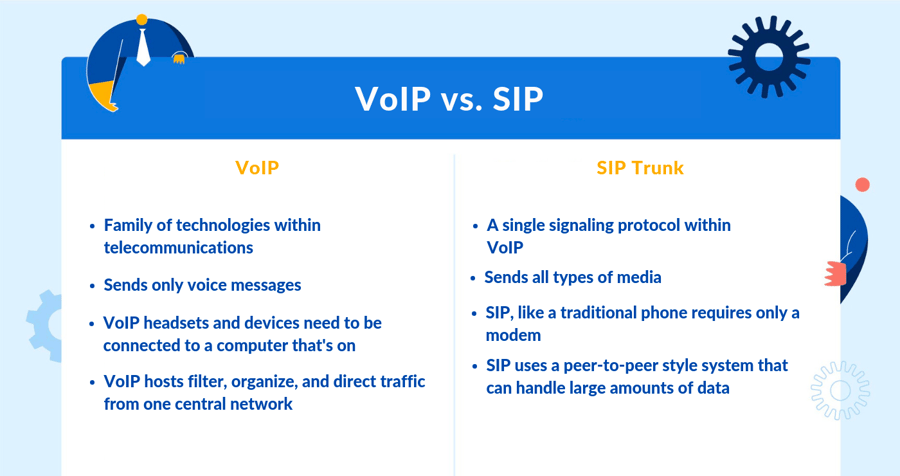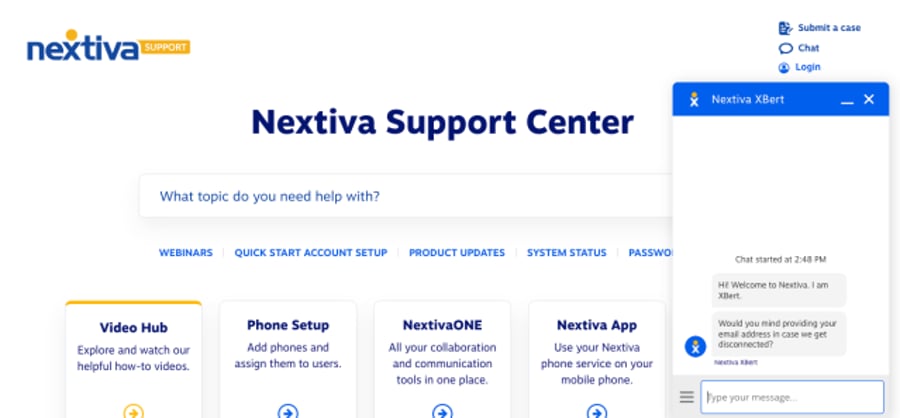SIP trunking can be an ideal communications technology for many businesses, typically offering great cost savings, solid scalability, and high call quality for outbound and inbound calls. Choosing a SIP trunking provider, however, is trickier.
Like Voice over Internet Protocol (VoIP), not all SIP trunking services are created equal, and you rarely want to go with the lowest-cost plan on the market.
In fact, some that claim to offer the lowest cost may have the lowest monthly fees yet charge high rates for extra phone numbers, e911 access, text messaging, long-distance calls, and so much more.
It’s not just about finding the lowest cost but finding the best value without getting tricked into paying more than you have to. Our SIP trunk pricing guide helps you figure out which service is best for you and your budget.
What Is SIP Trunking?
Session Initiation Protocol, or SIP, is an open standard for telephone connectivity between devices and software. It provides the technical means for calling, answering, and maintaining internet-based voice calls between users.
SIP trunking acts as a bundle of phone lines using SIP. Many small and large companies rely on the trunking provider to provide their office with a backbone of business phone lines for everyone in the office so long as you have enough SIP channels.

SIP trunking provides VoIP connectivity between an on-premises private branch exchange (PBX) and the public switched telephone network (PSTN).
SIP trunk doesn’t use analog telephone equipment to route voice calls. Instead, it sends your voice calls over data networks.
In other words, SIP trunks serve as an intermediary between your phone systems and a cloud phone service provider. That happens through a SIP server — a program that handles signaling and voice access to a centralized service, such as an IP PBX.
Simply put, a SIP trunk provides an office PBX with service for all its phone extensions to the outside world.
Why businesses choose SIP trunking
Many businesses today are considering VoIP systems relying on SIP trunking for several reasons:
- Replacing legacy systems — Some offices use legacy phone equipment that now needs to be replaced. One such example is the primary rate interface using integrated services digital network technology. These were sold in multiples of 23 lines each. Today, SIP trunking offers a lot more scalability thanks to its virtual switching instead of physical lines.
- Cost savings — SIP trunk services are significantly more cost-effective than traditional phone systems because traditional telephone equipment is expensive. Migrating analog phone systems to the cloud often results in significant savings.
- Increased scalability — You don’t have to worry about setting up physical phone lines for each new employee in the office, which can be expensive and time-consuming. Additional call paths ensure maximum reliability.
- Uses existing infrastructure — For those with an existing PBX or call center infrastructure, SIP trunks provide reliable voice service without requiring an overhaul. As the organization grows, just add more trunks.
These perks are easy to understand on their own. Still, SIP trunking with reliable providers consistently allows for high-quality calls at a massive scale, even if everyone in the office is placing a call at the same time.
| Feature | SIP Trunking | Traditional PRI |
|---|---|---|
| Cost per line | Low, ~$20/month (metered) | High, ~$100/month (fixed) |
| Scalability | Easy (add/remove lines) | Difficult (requires hardware) |
| Flexibility | Uses existing internet | Limited routing options |
SIP Trunk Pricing Models
There are two main ways SIP trunk providers price their services:
- Per-minute (metered): This is similar to a traditional phone plan where you are charged by the minute for your calls. This can be good for businesses that don’t make a lot of calls, but it can also be unpredictable and expensive if you have a lot of long calls or international calls.
- Unlimited: With this model, you pay a flat monthly fee for a certain number of channels (concurrent calls) and have unlimited calling to a specific area, usually local and domestic calls. This is a good option for businesses that make a predictable amount of calls each month. Some providers may offer unlimited plans for international calls as well, but these are typically more expensive.
Here are some other factors that can affect SIP trunk pricing:
- Number of SIP trunks: A SIP trunk typically includes a bundle of channels, anywhere from 10 to 100 lines. The more trunks you need, the more you will pay.
- Phone Numbers: You may need to pay an additional fee for each phone number you want to use with your SIP trunk service.
- Features: Some providers offer additional features, such as call forwarding and voicemail, for an extra fee.
It’s important to shop around and compare prices from different providers before you decide on a SIP trunk plan. Be sure to factor in all of the costs, including the monthly fee, per-minute charges, phone number fees, and any additional features you need.

How Much Does a SIP Trunk Cost?
Before choosing a SIP trunk service, it’s a good idea to understand what factors impact pricing and how that drives the total cost associated with the system.
On average, most businesses can expect to pay between $10 to $25 per SIP trunk per month, but the pricing can vary based on your VoIP provider and your call volume. For those on a metered plan, many providers charge additional fees for phone numbers (DIDs) and assess different charges depending on the volume and origination/destination of phone calls.
Addressed below are different factors that impact pricing, including monthly costs, setup fees, outbound call rates, add-ons, additional business phone numbers (direct inward dialing), and PBX costs.
Monthly costs
Many SIP trunking plans have monthly service costs, which are priced per channel of voice service. These typically offer an unlimited number of calls, though the number of minutes you get in those calls or additional features available to you (including call logs) may vary by pricing tiers.
Per-minute costs (pay as you go)
Some SIP trunk services offer per-minute costs, which are also known as “metered” costs or “pay-as-you-go” plans. In this case, you’ll be charged a flat fee for every minute spent using the SIP trunk system. Sometimes, these services will charge a flat monthly rate in addition to the metered per-minute costs.
It’s common for SIP pricing plans to charge a flat fee for calls to local numbers and another fee for long-distance or international calls.

Set up fees
Many VoIP and SIP trunk services require one-time set-up fees when you first sign up as a customer. They’ll get your system set up and connected for you. Some companies, however, may not charge setup fees.
Add-on products
Some SIP trunk services come with additional optional add-on products, which may include features such as caller ID and CNAM, call data records, and even business SMS connectivity.
Make sure you’re accounting for this when reviewing your budget; you either need to find an all-inclusive plan that has the features you need for a flat fee or find a lower-cost plan that you can still afford with all the additional products added on.
Additional PBX costs
SIP trunking is the service used to connect your on-premises phone system with the PSTN. As a result, you must still use a PBX to operate the SIP trunk service, which means that you can incur additional PBX costs.
Indirect PBX costs that can impact your costs associated with SIP trunking include:
- On-prem servers or cloud hosting
- Systems engineers
- Maintenance services
- PBX software licensing
- Security auditing
SIP Trunk Provider Pricing Comparison
Looking for a quick breakdown of SIP trunk provider service costs side-by-side?
Some companies offer straightforward and transparent pricing online, while others may require you to contact sales for customized quotes. That said, here’s the SIP pricing information you need:
| SIP Provider | Key Features | Monthly Plan (Unlimited Calling Nationwide) | Per Minute Costs (Metered) |
|---|---|---|---|
| Nextiva | Easy setup and works with almost all PBX solutions Straightforward pricing Includes a free local phone number and a toll-free number Superior reliability and customer support team | $30 | $0.008 per minute |
| Broadvoice | Omnichannel cloud contact center 24/7 tech and customer support Features like call attendants and routing available | $17 per user per month Three-year contract required | $11 monthly (5000 minutes included) and $0.029 per minute over 5000 minutes Three-year contract required |
| SIP.us | Fast and easy setup through an online dashboard Flexible options allow you to choose your own providers, including phones and carriers Microsoft Teams integrations | $24.95 per channel per month | N/A |
| Twilio | Easy scaling up or down No contracts, channel fees, or porting fees Fraud prevention features Worldwide coverage | Need to talk to sales for an unlimited plan. | $0.0053 per minute outbound (depending on location), $0.0034 per minute inbound $1.15 – $2.15 monthly for each phone number $0.75 per number for e911 |
| Telnyx | Features such as call recording, emergency calling, and custom voice routing Five-minute set-up process Private multi-cloud network with excellent uptime | Need to talk to sales for an unlimited plan. | $1 per month per number Inbound local calls: $0.0035 per minute Outbound local calls: $0.005 per minute E911: $1.50 per month per number |
Trunking vs. Business Phone Service
You might be wondering about the differences between SIP trunking vs. an all-inclusive business phone system. While they both use VoIP, they differ in terms of features, functionality, and ease of use.
Business phone systems are hosted and managed entirely on the provider’s side. This is one option for VoIP phone lines, allowing you to leverage the power of the internet to increase call quality and overall scalability, even with simultaneous calls.
SIP trunking, on the other hand, potentially lets you use hardware that you already have in the office.

These are the core differences you’ll see:
If you’re considering hosted PBX and SIP trunking, here are the key differences and comparisons you should keep in mind:
- Cost of initial setup — A hosted PBX costs less if you have no on-prem PBX equipment, low for SIP if you already own equipment.
- Ongoing costs — Expect to pay between $15 and $60 per phone line per month.
- Maintenance — Your VoIP provider handles maintenance and updates for hosted PBX.
- Company size — Hosted PBX systems are best for small businesses. SIP trunking is best for high-volume call settings, such as at a call center.
- Call quality — Hosted PBX is suitable for fewer concurrent calls, while SIP trunking tends to handle high volume much better, depending on your PBX solution.
- Security — SIP trunking offers equivalent security features at a technical level, but a Hosted PBX can be connected to Single Sign On and call logs are readily available to IT admins.
SIP trunking typically requires that businesses are technical, and it can become complicated relatively quickly. It may also lack customer support that IT managers (and users!) need, though this depends on the provider.

It’s worth considering that the cloud phone system by Nextiva can offer all the advanced features, call uptime, customer support, and ease of use that growing businesses need.
Estimating SIP Trunk Usage
If you’re trying to assess how much you’ll spend with SIP trunking, you first need to consider your estimated SIP trunk usage.
First, you’ll need to know the direct-dial numbers, known as direct inward dialing. These phone numbers allow your company to connect a block of phone numbers to your business’s PBX and its extensions so you can set up virtual numbers. Direct Inward Dialing is easily scalable as your business grows.

You’ll also want to consider the cost of E911, which is part of the emergency phone system that automatically provides the location of the caller to 911 dispatchers. This has been a mandated service for VoIP providers since 2005.
Finally, think about your average inbound and outbound call volume. It’s important.
Knowing how many lines you use concurrently will affect the cost of a SIP trunk. Here’s a quick video that explains this for the rest of us.

This changes month-over-month during seasonal trends, or you might expect it to increase as your business scales up. Your estimated monthly averages are a good place to start.
Tips to Lower Your SIP Trunking Costs
If you know you want to use a SIP trunk service but want to keep your costs down, consider these tips:
1) Choose the right pricing model
Consider your volume of inbound vs. outbound calls, average call minutes, and the features you need. This can help you choose the right monthly price point and the right pricing model.
If you generally have lower usage, a metered plan could work. But if you’re continuing to scale your voice usage, an unmetered SIP trunk plan offers the best value.
2) Bundle your services
Many SIP trunk providers, such as Nextiva, offer other VoIP or telecom services. You can bundle services and, in many cases, receive a discount on the total package.
3) Negotiate your contract
Work directly with a sales representative to find a custom plan for you. This may not be an option with all SIP trunk providers, but it never hurts to ask to find the best monthly fee.
For instance, if you don’t need direct inward dial numbers for every user, you could save on those extra costs.
4) Manage your call volume
While this can be tricky, there are strategies you can use to reduce call volumes. A lot of SIP trunk services and PBX systems are priced by concurrent calls — or phone calls happening in real-time.
For example, having support and help desk sections on your website can answer commonly asked questions that customers may have otherwise called for. Live chat options on your site can also help mitigate a high call volume.

Choosing a Reliable SIP Trunk Provider
When choosing a reliable SIP trunk provider, look for the following:
- Reliability with redundant points of presence (POPs) and impressive uptime
- 24/7 customer support that’s available with knowledgeable, friendly reps
- Ease of use, including ways to scale your SIP channels instantly
SIP trunking is a cinch with Nextiva. Simple. Affordable.
Get your business voice, messages, video meetings, and more integrated in ONE powerful cloud PBX.
With affordable SIP trunk pricing, you can take your business to the next level for less. Nextiva can power your entire phone system with our powerful cloud-based PBX.
Imagine a business VoIP phone system that lets you grow and doesn’t let you stress about its cost or ongoing maintenance.
… It’s here. NextivaONE is the complete business communications solution for companies so their teams stay connected and work smarter. Hang up the old-school PBX and answer the call to the better way to work.
FAQs
Businesses choose SIP trunking for several reasons. The top benefits include:
– Allows companies to use existing hardware and phone lines
– Offers cost-effective voice service and scalability compared to traditional phone systems
– Handling concurrent phone calls with multi-channel trunks
– Straightforward setup and maintenance with a qualified IT technician
– Attractive domestic and international calling across the United States, Canada, and the United Kingdom
Set up a SIP trunk with the following steps:
1. Access your PBX software settings as an administrator.
2. Add credentials from your SIP trunk provider, including username, password, phone numbers, and the host/domain.
3. Verify with a few SIP calls in and out from a known working cell phone
VoIP provides internet-based phone calling for one user at a time. VoIP most commonly operates on the SIP protocol. The SIP protocol is an open standard for calling others and providing the media (audio) reliably.
With a VoIP provider, you can access many calling features, such as call forwarding, call recording, call routing, and softphone/desk phone connectivity, without any technical setup.
A SIP trunk, on the other hand, is meant for multiple users (of an office) to use for phone calls. SIP trunking uses a PBX installed either on-site or in the cloud to provide users with phone service.
There are a few ways to optimize your telecommunications costs.
1. Switching to SIP trunk or cloud-based VoIP solutions that cost less than traditional phone lines
2. Monitor your inbound and outbound call volumes
3. Choose a pricing plan from a provider that aligns with your budget and needs
4. Consider a multi-year commitment to obtain the best SIP trunk pricing

















 Business Communication
Business Communication 









